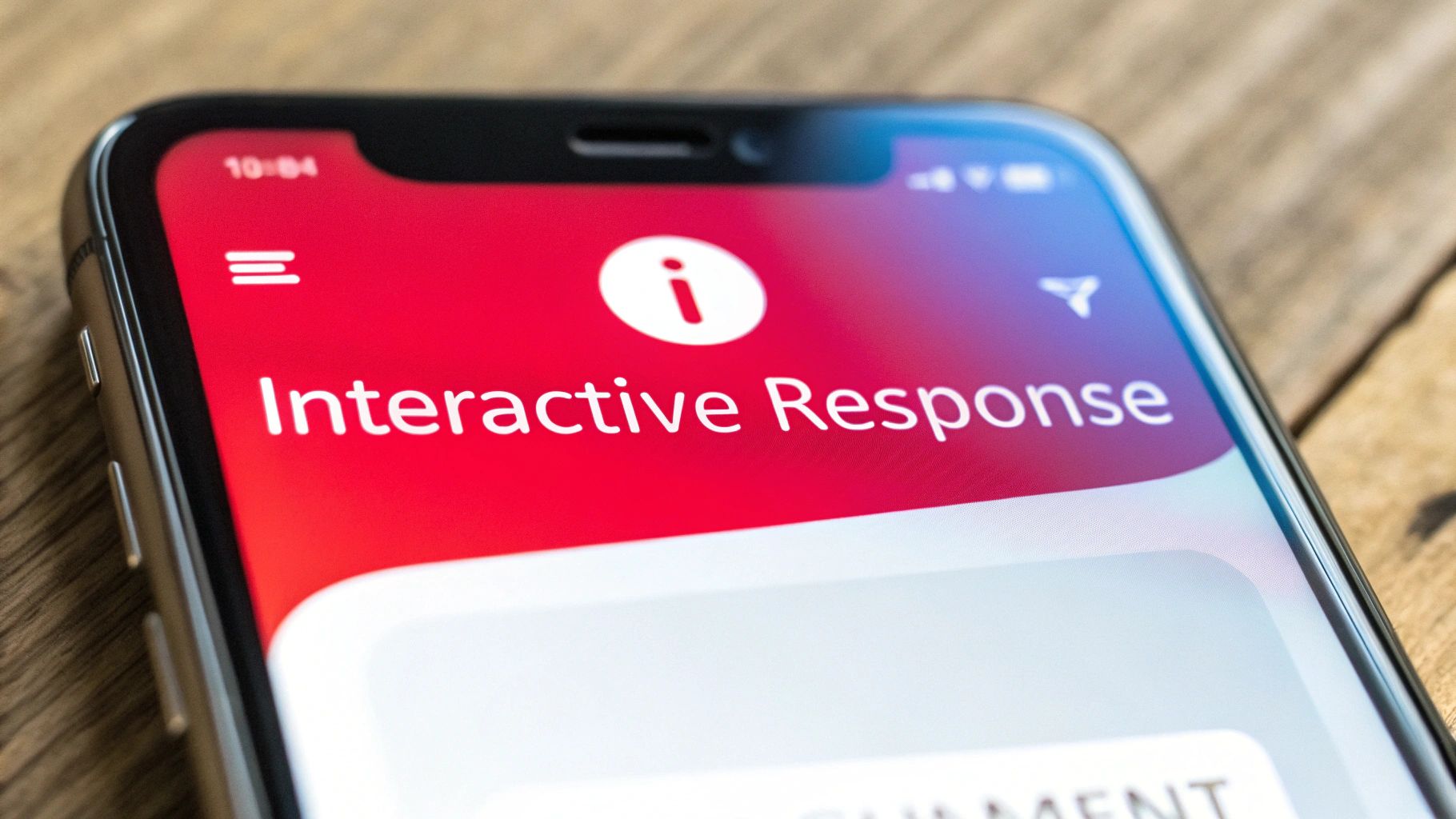The Evolution of Interactive Voice Response Services

Interactive voice response (IVR) systems have become a standard part of how businesses handle customer service calls. While today's systems can understand natural speech and route calls intelligently, they started from much simpler beginnings. The story of how IVR evolved shows just how far this technology has come in improving customer communication.
The origins of IVR technology can be traced back to the 1930s with the invention of the Voder machine by Homer Dudley at Bell Laboratories. As the first device capable of creating artificial human speech, the Voder was groundbreaking despite its basic sound quality. This early innovation set the stage for all modern speech synthesis development.
From Touch-Tone to Natural Language
For many years, IVR systems relied on customers pressing phone buttons to work through menu options. This often created frustrating experiences with long waits and difficulty reaching the right department. The introduction of natural language processing (NLP) marked a major improvement in how these systems work.
The Impact of NLP and AI
With NLP, IVR systems can now understand when customers explain what they need in regular conversation. This means no more pressing numbers to navigate complex menus - customers simply state their request. AI-powered systems also learn from each interaction to get better over time. For instance, by analyzing common customer questions, the system can improve how it directs calls to the right department.
The Rise of Omnichannel Communication
Today's IVR goes beyond just phone calls. These systems now connect smoothly with other communication channels like web chat, email and social media. This creates a consistent experience whether customers call, message or email a business. Companies can use this connected approach to better understand customer needs and provide more personal service across all channels. The result is a more complete and effective way to help customers get what they need.
Breaking Through Traditional IVR Limitations

Most people associate interactive voice response (IVR) systems with tedious phone menus and endless button pressing. But IVR technology has come a long way, thanks to advances in cloud computing, AI, and data analysis. These improvements are changing how businesses handle customer phone interactions.
Cloud-based IVR systems give companies new options for managing calls effectively. Small and medium businesses can now access the same advanced features that were once limited to large corporations. The systems easily scale up or down based on call volume and integrate smoothly with other business tools.
Artificial intelligence (AI) and natural language processing (NLP) have made IVR interactions feel more natural and human. Instead of working through rigid menus, callers can simply state what they need in their own words. The system understands and routes them appropriately, leading to faster resolutions. This shift began in the 1980s when Leon Ferber's Perception Technology made digital speech processing more affordable. Learn more about the evolution of this technology: The history of IVR technology.
Using Data to Improve IVR Systems
Modern IVR systems generate valuable data about customer interactions and preferences. Companies can see which issues come up most often, spot calling patterns, and measure how well their IVR setup performs. This information helps them continually refine the system to better serve customers' needs.
Real Success Stories with Modern IVR
Many businesses are seeing great results with advanced IVR features. Some use AI to customize greetings and options based on past interactions, making the experience more personal while handling calls more efficiently. Others have added self-service options for routine tasks like checking orders or making payments, which frees up agents to handle more complex issues.
These improvements show how IVR has evolved beyond simple call routing. When implemented thoughtfully, it becomes a key tool for boosting customer satisfaction, cutting operational costs, and supporting business growth.
Mastering Natural Language Processing Integration
Modern customer service has seen significant changes in how Interactive Voice Response (IVR) systems work. One major improvement is the addition of Natural Language Processing (NLP), which allows IVR systems to understand and respond to regular conversations. This has fundamentally changed how businesses handle customer interactions.
Understanding the Power of NLP in IVR
NLP makes it possible for IVR systems to grasp the subtle ways people speak. Instead of pressing buttons for different menu options, customers can simply explain what they need in their own words. For instance, rather than navigating through numbered options, they can directly say "I need help with my bill." This creates a more comfortable experience and reduces frustration. The system can even recognize repeat callers and adjust its responses based on their history.
The impact of NLP on IVR systems has been significant. By letting callers use natural speech instead of keypad tones, these systems have become much better at handling customer needs. Recent data shows strong customer preference for these improved systems - 66% of customers prefer natural language IVR, and 63% want personalized experiences from these systems. For more details, see the Interactive Voice Response Market Research.
Optimizing NLP for Enhanced Customer Experience
Getting the most out of NLP requires careful setup and ongoing improvements. A key part is teaching the system to understand specific industry terms and phrases. For example, medical IVR systems need to know healthcare terminology, while banking systems must understand financial terms. This focused training helps the system understand requests more accurately and direct calls to the right department.
Measuring and Refining NLP Performance
To ensure NLP-powered IVR systems meet customer needs, businesses need to track specific measurements. These include how many calls are completed successfully, customer satisfaction ratings, and how long calls take to handle. Looking at this information helps identify areas that need work and ways to make the system better. This ongoing process of checking and improving ensures the NLP system keeps working well for both the business and its customers.
Creating Seamless Digital Experiences

Many successful companies now see interactive voice response (IVR) as an essential part of their overall customer service strategy. Rather than treating phone support as separate from other channels, these businesses are connecting IVR with their websites, mobile apps, and social media platforms. This integrated approach makes perfect sense - customers often switch between different ways of getting help during a single interaction.
Connecting the Dots: IVR and Omnichannel Strategies
Consider this common scenario: A customer browses products on a company website, then clicks to call customer service through the IVR system. Because the IVR can see what the customer was viewing online, it immediately provides relevant options and information. The customer doesn't need to repeat themselves or start over, making the experience quick and easy.
Modern businesses rely on cloud systems and real-time data to keep track of customer interactions across all channels. For instance, when someone reaches out through the IVR after sending a message on social media, the service agent can see their full history. This allows for personalized help based on previous interactions.
The rise of remote work and service during COVID-19 showed just how important IVR systems are for managing high call volumes efficiently. For more details on how the pandemic impacted IVR adoption, see this analysis from Fortune Business Insights on the IVR market.
Intelligent Routing and Cross-Channel Effectiveness
Smart call routing helps create better customer experiences. By looking at caller data and history, IVR systems can connect people directly to the right department or agent for their specific needs. This means shorter wait times and faster solutions.
But having connected channels isn't enough on its own. Companies need to carefully track how well their different service channels work together. By measuring customer satisfaction scores, time to resolution, and which channels customers use most, businesses can spot problems and make improvements. This focus on data helps companies deliver consistently good service no matter how customers choose to reach out.
Building Your IVR Implementation Strategy

Setting up an interactive voice response (IVR) system takes thoughtful planning and a systematic approach. The process goes beyond just selecting and installing software - it requires careful consideration of your business goals, technical requirements, and customer needs. A clear strategy helps ensure your IVR system delivers value while providing an excellent customer experience.
Defining Your IVR Needs and Objectives
Start by identifying exactly what you want your IVR system to accomplish. Are you looking to decrease wait times, provide around-the-clock self-service options, or improve how calls are routed? Setting specific goals will guide both your vendor selection and system configuration. For instance, if reducing agent workload is your priority, you'll want to focus on robust self-service capabilities.
Selecting the Right IVR Vendor
The success of your IVR system depends heavily on choosing the right provider. Key factors to evaluate include the vendor's industry experience, available features, integration capabilities, and cost structure. Look for providers who understand your specific business needs and offer solutions that can scale as you grow. Alohaa is one option that provides virtual phone numbers, cloud call centers, and integrations with popular communication tools.
Planning Your Implementation Timeline and Budget
Creating a realistic schedule and budget is essential for smooth implementation. Account for system setup time, employee training periods, and thorough testing phases. Develop a detailed budget covering all expenses from software licensing to ongoing maintenance. This careful planning helps avoid unexpected costs and delays during rollout.
Managing Stakeholder Expectations and Communication
Clear communication with all stakeholders is vital throughout implementation. Keep everyone informed about progress, address concerns promptly, and explain how the new system will affect daily operations. This openness helps gain support from all parties and ensures a smoother transition.
System Integration and Testing
After selecting your IVR system, focus on connecting it with your existing tools like your CRM and call center software. Thorough testing is essential to confirm all components work together properly and the system performs as expected.
Ongoing Optimization and Performance Monitoring
Once your IVR system is live, regular monitoring and fine-tuning become crucial. Track important metrics like call completion rates, customer satisfaction scores, and handling times. Use this data to improve system prompts, call flows, and self-service options. Regular assessment and updates ensure your IVR system continues to meet both business objectives and customer needs.
Preparing for the Future of Voice Interaction
The world of Interactive Voice Response (IVR) is evolving beyond basic menu systems. New advances in AI, security, and data analysis are creating smarter ways for businesses to interact with their customers through voice technology.
The Rise of AI-Powered Personalization
AI is making IVR systems more personal and intuitive. Modern systems can now recognize callers by their voice, greet them by name, and understand what they likely need based on their history. A customer calling about a previous order, for example, can be connected directly to the right department without going through multiple menus. This creates a smoother experience that feels more like talking to a real person.
Biometric Authentication for Enhanced Security
Voice-based biometric authentication is adding better security to IVR while making it easier to use. Instead of remembering passwords or PINs, customers can verify their identity just by speaking. This is especially helpful for sensitive transactions like banking, where security is crucial but shouldn't get in the way of good service.
Predictive Analytics: Anticipating Customer Needs
By analyzing patterns in customer behavior and past interactions, predictive analytics helps IVR systems guess what callers need before they ask. If someone regularly calls about the same product, for instance, the system can automatically offer relevant help resources or connect them to a specialist. This smart approach helps resolve issues faster and leaves customers more satisfied.
Evaluating New IVR Technologies
To make the most of these advances, businesses need to carefully assess which new IVR features actually add value for their specific needs. This means looking at factors like implementation costs, technical requirements, and long-term benefits rather than chasing every new trend.
Maintaining Competitive Advantage Through Innovation
Success in customer service requires staying current with useful new technologies while focusing on what works best for your business and customers. This means investing in staff training, following industry best practices, and working with IVR providers who understand your goals. Companies that balance innovation with practical needs can build better customer experiences that set them apart.
Ready to improve your customer communications? Discover how Alohaa's omnichannel platform can help your business connect better with customers, or book a demo today to see how advanced tools can make a difference.

%20(1).svg)



.png)
.png)
.png)
.svg)

